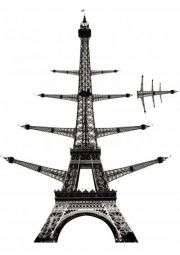Trees, forests and the Eiffel tower reveal theory of design in nature

What do a tree and the Eiffel Tower have in common? According to a Duke University engineer, both are optimized for flow. In the case of trees, the flow is of water from the ground throughout the trunk, branches and leaves, and into the air. The Eiffel Tower's flow carries stresses throughout the structure without collapsing under its own weight or being downed by the wind.
For most engineers, the laws governing fluid and solid mechanics like these examples are like oil and water – they just don't mix.
However, a theory developed by Adrian Bejan, J.A. Jones Professor of Mechanical Engineering at Duke's Pratt School of Engineering and colleague Sylvie Lorente, professor of civil engineering at the University of Toulouse, France, explains how these disparate forces can co-exist within the same theory.
"We believe that the main function of the tree is to facilitate the flow of water from the ground and into the atmosphere," Bejan said. "To achieve that function, the tree is ideally designed to not only maximize the flow of water, but in order to be successful in the real world, it must also be able to withstand the stresses of the wind. It is exquisitely designed to do just that."
The constructal theory, which Bejan started describing in 1996, is based on the principle that flow systems evolve to balance and minimize imperfections, reducing friction or other forms of resistance, so that the least amount of useful energy is lost. While the tree is the most common model used by Bejan to explain the theory, other similar examples exist in nature, such as the rivers and streams that make up a delta or the intricate airways of the lungs.
In their latest theoretical formulation, the engineers focused on fundamental principles to explain the "designedness" of nature, or why things are constructed the way they are. Using the constructal theory, they deduced the structure of the individual tree, as well as its root system and its place in the forest, as a microcosm of the flow of water in nature.
This new application of the constructal theory was published early online in the Journal of Theoretical Biology. Bejan and Lorente's work was supported by the Air Force Office of Scientific Research.
"The tree is a physical flow architecture that has evolved to meet two main objectives – maximum mechanical strength against wind and maximum access for water coming from the ground through the tree and into the atmosphere," Bejan said. "In the larger sense, the forest itself is a flow system with the same mechanical properties and functions as the individual tree, facilitating the flow of water across the globe."
As the branches grow out from the trunk, the ratio of their circumferences decreases in proportion to the trunk's decreasing circumference as it rises.
"Winds come in many speeds, but their ultimate effect is cutting off trunks, branches and leaves, so whatever is too long or sticks out too much is shaved off," Bejan said. "So the pattern of the tree is the result of the never-ending assault by the wind."
The resulting patterns and proportions, like the similar ones of the Eiffel Tower, are predicted by the constructal theory, Bejan said.
"If the purpose of a tree was not to transport water, it would look like the Eiffel Tower," said Bejan, half jokingly. "It looks like Mr. (French engineer Gustave) Eiffel, without knowing it, designed a structure that corresponds with our constructal theory."
Source: Duke University
















